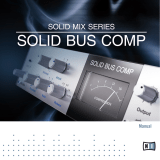
OPERATION
12 | PreSonus 2007
3.2 A BRIEF TUTORIAL ON DYNAMICS PROCESSING
The compressor in the Studio Channel is a fully variable, ultra-fast and smooth VCA-based circuit with all of the
controls needed for a wide range of compression settings: ratio, threshold, attack, release and gain make up. The
VCA-based compressor is known for musicality as well as ultra fast attack with the ability to tame the fastest
transients. From slap bass, to snare drum, to vocals, the Studio Channel’s compressor stage allows you to record
as hot as needed without clipping giving you total dynamic control. What follows is an excerpt from brief
tutorial on dynamics processing written by PreSonus President and Chief Technical Officer, Jim Odom. It is
included to help you get the most out of your Studio Channel. This tutorial will take you through the basics of
dynamics processing as well as explain the various types of dynamics processors.
3.2.1 Common Questions Regarding Dynamics
What is dynamic range?
Dynamic range can be defined as the distance between the loudest possible level to the lowest possible level.
For example, if a processor states that the maximum input level before distortion is +24dBu and the output
noise floor is -92dBu, then the processor has a total dynamic range of 24 + 92 = 116dB.
The average dynamic range of an orchestral performance can range from -50dBu to +10dBu on average.
This equates to a 60dB dynamic range. 60dB may not appear to be a large dynamic range but do the math
and you’ll discover that +10dBu is 1000 times louder than -50dBu!
Rock music on the other hand has a much smaller dynamic range, typically -10dBu to +10dBu, or 20dB. This
makes mixing the various signals of a rock performance together a much more tedious task.
Why do we need compression?
Consider the previous discussion: You are mixing a rock performance with an average dynamic range of
20dB. You wish to add an un-compressed vocal to the mix. The average dynamic range of an uncompressed
vocal is around 40dB. In other words a vocal performance can go from -30dBu to +10dBu. The passages
that are +10dBu and higher will be heard over the mix. However, the passages that are at -30dBu and below
will never be heard over the roar of the rest of the mix. A compressor can be used in this situation to reduce
(compress) the dynamic range of the vocal to around 10dB. The vocal can now be placed at around +5dBu.
At this level, the dynamic range of the vocal is from 0dBu to +10dBu. The lower level phrases will now be
well above the lower level of the mix and louder phrases will not overpower the mix, allowing the vocal to ‘sit
in the track’. The same discussion can be made about any instrument in the mix. Each instrument has its
place and a good compressor can assist the engineer in the overall blend of each instrument.
Does every instrument need compression?
This question may lead many folks to say ‘absolutely not, overcompression is horrible’. That statement can be
qualified by defining ‘overcompression’. The term itself, ‘overcompression’ must have been derived from the
fact that you can hear the compressor working. A well designed and properly adjusted compressor should not
be audible! Therefore, the overcompressed sound is likely to be an improper adjustment on a particular
instrument.
Why do the best consoles in the world put compressors on every channel? The answer is simply that most
instruments need some form of compression, oftentimes very subtle, to be properly heard in a mix.























